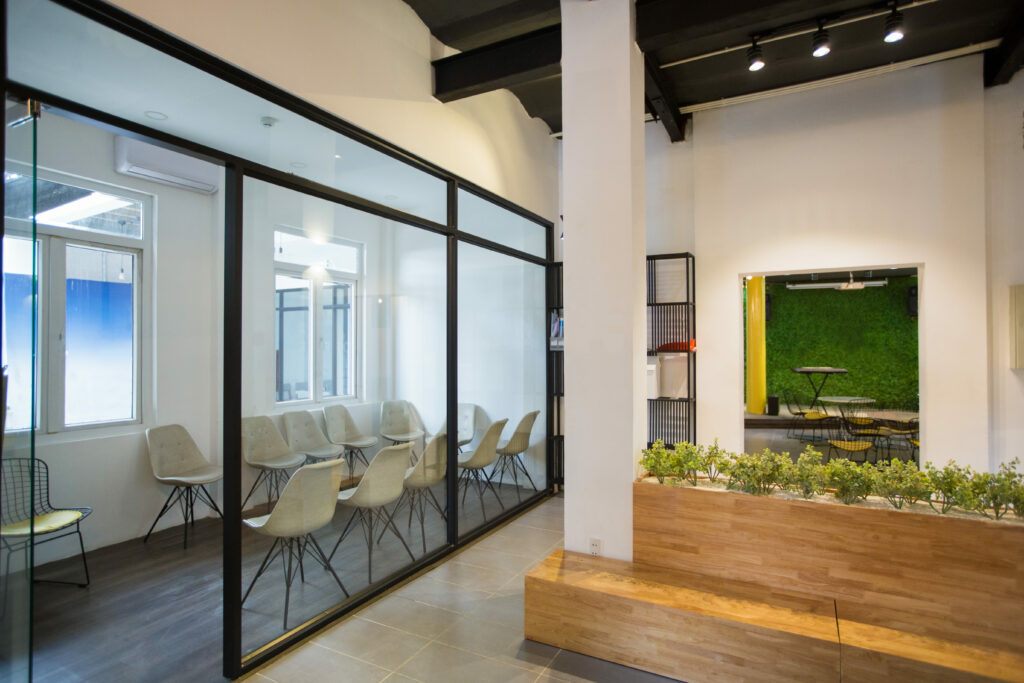Glass partitions are not only aesthetically pleasing but also offer numerous sustainable advantages that contribute to a greener environment. From energy efficiency to enhanced indoor air quality, here are detailed pointwise explanations of the sustainable benefits of glass partitions:

1. Natural Light Optimization:
– Glass partitions maximise the use of natural light, reducing the dependency on artificial lighting during daylight hours.
– Increased natural light penetration helps lower electricity consumption, resulting in reduced energy bills and carbon emissions.
2. Energy Efficiency:
– Glass partitions with high-quality insulation properties help regulate indoor temperatures by minimising heat transfer.
– This thermal insulation reduces the need for excessive heating or cooling, leading to significant energy savings and a smaller carbon footprint.
3. Space Flexibility and Optimization:
– Glass partitions offer flexibility in space utilisation, allowing for easy reconfiguration and adaptation to changing needs.
– By optimising space usage, organisations can minimise the need for new construction or expansion, thereby conserving resources and reducing environmental impact.
4. Recyclability and Sustainability:
– Glass is a highly recyclable material, making glass partitions an environmentally friendly choice.
– At the end of their lifespan, glass partitions can be recycled into new products, reducing landfill waste and conserving raw materials.
5. Improved Indoor Air Quality:
– Unlike solid walls, glass partitions allow for better air circulation and ventilation throughout interior spaces.
– Improved indoor air quality contributes to the health and well-being of occupants by reducing the risk of indoor pollutants and allergens accumulation as compared to other materials.
6. Sound Insulation and Noise Reduction:
– Glass partitions equipped with sound-insulating features help minimise noise transmission between different areas of a building.
– By creating quieter work environments, glass partitions promote productivity and well-being while reducing the need for soundproofing materials that may have negative environmental impacts.
7. Durability and Longevity:
– High-quality glass partitions are built to last, requiring minimal maintenance and replacement over time.
– Their durability reduces the consumption of resources associated with frequent repairs or replacements, making them a sustainable long-term investment.
8. Promotion of Green Building Certifications:
– Incorporating glass partitions into building design aligns with green building standards such as LEED (Leadership in Energy and Environmental Design) certification.
– Meeting these sustainability criteria enhances the overall environmental performance of buildings and demonstrates a commitment to eco-friendly practices.
9. Daylight Harvesting for Energy Savings:
– Glass partitions facilitate daylight harvesting strategies, where natural light is strategically managed to optimise energy efficiency.
– Daylight harvesting reduces reliance on artificial lighting and associated energy consumption, leading to significant energy savings and environmental benefits.
10. Enhanced Aesthetic Appeal:
– Glass partitions contribute to the aesthetic appeal of interior spaces by creating an open, modern, and visually appealing environment.
– Their transparent nature promotes a sense of connection with the surrounding environment, fostering a more sustainable and nature-conscious mindset among occupants.
By embracing the sustainable benefits of glass partitions, businesses, homeowners, and architects can contribute to a more eco-friendly built environment while enjoying the functional and aesthetic advantages they offer. From energy savings to improved indoor air quality, glass partitions play a vital role in creating sustainable, healthy, and vibrant spaces for generations to come.

![[https___freepicdownloader.com_]-elegant-professional-office-space-with-glass-walls-modern-furniture-office-is-bright-airy-with-plenty-natural-light-normal](https://zilmaa.com/wp-content/uploads/2024/05/https___freepicdownloader.com_-elegant-professional-office-space-with-glass-walls-modern-furniture-office-is-bright-airy-with-plenty-natural-light-normal-626x313.jpg)





